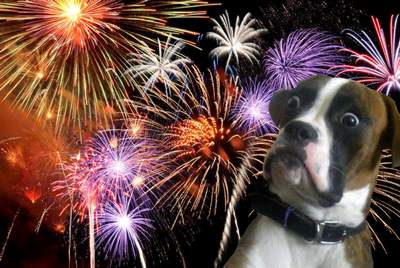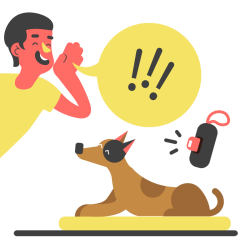Dog Fireworks. Help Your Dog Who’s Afraid of Fireworks.
Post Date:
July 18, 2024
(Date Last Modified: November 13, 2025)
Strategies for supporting dogs during fireworks. Focus on behavior, environment, and veterinary input.
Why fireworks scare dogs
Dogs respond to fireworks for several sensory and learning-based reasons, and recognizing the mechanisms behind a dog’s fear helps target the right interventions. Acoustic sensitivity is a primary factor: dogs perceive higher frequencies and sharper transients than humans, which can make the crack and whistle of fireworks especially salient; dogs can hear frequencies roughly between 40,000 and 60,000 Hz, far above the typical human range [1]. Firework detonations are also intense in amplitude, and peak sound pressure near a launch can exceed 150 dB, creating startling pressure waves that may trigger a panic response in sensitive animals [1]. Even at some distance, short-lived pulses from consumer fireworks commonly produce levels above 120 dB, enough to cause acute startle and displacement behaviors in many dogs [1].
Learned associations compound the problem: a single traumatic or highly stressful noise event can produce a conditioned fear that generalizes to similar sounds, with avoidance and heightened arousal sometimes measurable within 24 to 72 hours after the event [1]. Breed and life-stage factors influence vulnerability; for example, noise aversions commonly emerge in young adult dogs, with onset often reported between about 1 and 3 years of age in behavior clinic records, though individual risk varies by temperament and prior experience [1]. The behavioral and physical consequences can include frantic attempts to escape, self-trauma such as cuts or broken nails, destruction of household items, and the development of chronic anxiety if exposures recur without effective intervention [1]. Identifying whether the primary driver is raw auditory sensitivity, associative learning, medical discomfort, or some combination helps prioritize steps such as environmental modification, counterconditioning, or veterinary evaluation.
Recognizing fearful behaviors
Watch for changes in posture and movement that signal noise-related fear, because early recognition lets you choose appropriate interventions. Common body language includes low posture, trembling, tucked tail, flattened ears, and restless pacing that may alternate with attempts to hide; some dogs will press their body into corners or under furniture when startled. Vocalizations such as prolonged barking, whining, or frantic howling often accompany attempts to flee and can escalate to destructive behavior as the animal seeks an exit. Timing matters: some dogs show anticipatory signs before predictable events, while others react only when a loud sound occurs; patterns in timing help distinguish an emerging phobia from occasional startle. Severity exists on a continuum from brief startle responses with rapid recovery to sustained panic that results in escape attempts, self-injury, or persistent avoidance of previously enjoyed activities, and recognizing where an individual sits on that spectrum guides whether to manage at home or seek expedited professional help.
Veterinary check and medical considerations
Involve a veterinarian when fear is new, worsening, or accompanied by physical symptoms, because medical conditions can mimic or worsen behavioral signs. A vet will rule out pain, hearing impairment, neurological disease, and endocrine disorders during a baseline physical exam and may recommend bloodwork or specific diagnostics if indicated. A thorough behavioral history helps the clinician decide whether medical therapy, behavior modification, or specialist referral is the right next step; when medical causes are excluded, coordinated care with an experienced behaviorist often produces the best outcomes. Referral for further behavioral consultation is appropriate when home strategies provide limited progress or when the dog’s reactions present a safety risk to themselves or others.
Desensitization and counterconditioning basics
Use gradual, controlled exposure paired with positive outcomes to change the dog’s emotional response to firework sounds. The two core elements are incremental exposure that never pushes the dog into panic and consistent pairing of the trigger with high-value, pleasant outcomes so the sound predicts something good rather than danger. Start at a level where the dog notices the sound but remains relaxed, then slowly increase intensity and variability only as the dog shows comfort; abrupt jumps in volume or context can undo progress by re-establishing fear. Counterconditioning relies on giving rewards that are reliably more appealing than the sound is aversive, maintaining clear timing so the dog learns the association; avoid accidental reinforcement of fear-driven behavior by not rewarding frantic escape attempts.
Practical training plan and timeline
Implementing behavioral work benefits from a predictable schedule and measurable goals so progress can be tracked over time. Begin with short, low-intensity sessions in a quiet environment to build a relaxed baseline, then add brief exposures paired with rewards, keeping sessions regular and positive. Structure each session with a calm warm-up to prime relaxation, a controlled exposure phase with immediate rewarding, and a calm-down period that reinforces the relaxed state after training ends. Monitor signs of stress during each session and adjust the pace when the dog shows repeated tension, and consult a professional behaviorist for stepwise advancement if progress plateaus or if the dog’s reactions escalate.
Creating a safe, sound-managed environment
Environmental modifications reduce sensory load and provide predictable comfort during fireworks events. Provide a denlike area sized so the dog can stand and turn, with familiar bedding and toys that carry household scents; placing an unwashed item of clothing with the owner’s scent can be reassuring. Reduce incoming noise through buffering measures such as closing windows and heavy curtains, and consider continuous low-level background sound designed for relaxation to blunt sudden transients. Control lighting to minimize startle from flashes, and secure all exits to prevent escape attempts; ensure collars carry up-to-date identification and that microchip records include current contact information so recovery is faster if the dog is lost.
Helpful products and aids
Choose tools that have some clinical or consensus support and integrate them with training rather than relying on any single product as a cure. Pressure wraps that apply gentle, even pressure can reduce observable anxiety in many dogs for the duration of an acute event, with owners typically using them for periods of 1 to 4 hours during known noise exposure [2]. Pheromone diffusers are commonly recommended as an adjunct and are typically deployed at least 24 hours before an anticipated event to allow the environment to equilibrate [2]. Over-the-counter calming supplements vary widely in composition and evidence, and published guidelines advise treating them as supportive measures rather than primary therapy, with some products requiring daily dosing for 2 to 4 weeks before measurable benefit is expected [5]. Validated sound-playback equipment and apps used for desensitization should offer adjustable volume and realistic acoustics and are usually introduced in systematic sessions over multiple weeks to months as part of a behavior plan [3]. Reserve prescription anxiolytics or sedatives for dogs whose reactions present safety risks or when behavioral methods alone do not achieve control; pharmacologic plans are individualized and should be managed by a veterinarian with follow-up monitoring [2].
| Aid | Purpose | Typical timing | Notes |
|---|---|---|---|
| Pressure wrap | Short-term calming | 1–4 hours during events | Fit snugly; introduce before events |
| Pheromone diffuser | Background calming scent | Start ≥24 hours prior | Best as an adjunct to training |
| Sound therapy app | Desensitization | Daily sessions over weeks | Use calibrated, realistic sounds |
| Calming supplements | Supportive aid | Daily for 2–4 weeks to assess | Check interactions with meds |
What to do during fireworks (day-of actions)
On event days use low-arousal management: remain nearby, move slowly, and let the dog choose whether to accept handling or proximity, because calm caregiver behavior helps lower the dog’s stress without teaching avoidance of safety-seeking [4]. If you use trained cues and a previously conditioned reward, present them during low-amplitude noise bouts and keep interactions brief and predictable to maintain the counterconditioning effect [3]. Avoid punishment or forceful restraint, and do not forcibly expose the dog to loud sounds; both actions increase risk of escalation and can worsen noise aversion over repeated exposures [4]. Keep exits secured and have a rapid containment plan ready; if a dog bolts, immediate retrieval and safe containment within the first few minutes improves recovery chances and reduces injury risk, so ensure access to a secure crate or room [1].
Preparing for parties, travel, and boarding
Plan ahead and communicate details to anyone caring for the dog so management is consistent and predictable across settings. Create a calming kit that includes a familiar blanket or toy, at least a 3-day supply of any necessary supplements or prescribed medications, clear dosing instructions, and contact information for the primary veterinarian and behaviorist [3]. When selecting boarding facilities or sitters, prioritize options that document experience with anxious dogs and that will follow your established desensitization and medication plan; ask about their intake procedures and whether they can provide single-room, low-stimulus housing when needed [2]. For travel, familiarize the dog with the travel crate over multiple sessions lasting 10 to 30 minutes each day in the weeks before departure to build positive associations and reduce travel-specific stress [3].






